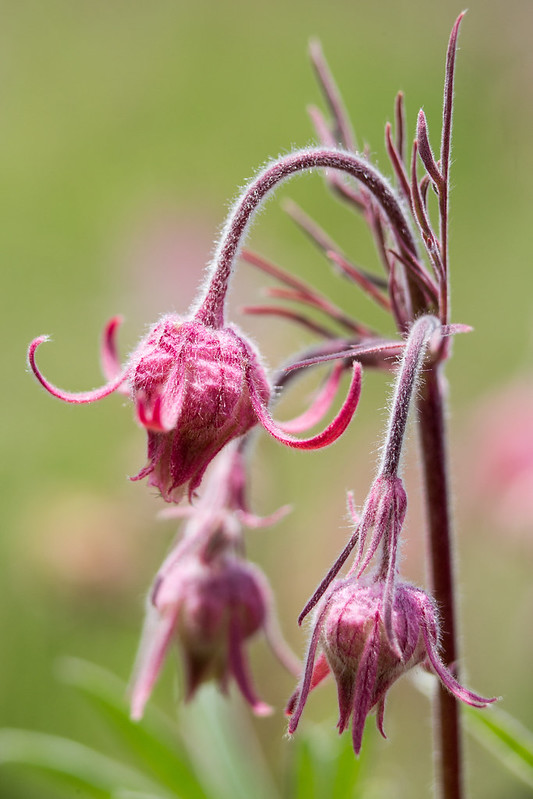Prairie Smoke (Geum triflorum), also known as Old Man’s Whiskers or Three-Flowered Avens, is a charming native perennial prized for its ethereal, wispy seed heads and delicate nodding blooms. A true prairie gem, this low-growing plant brings architectural interest and early-season color to rock gardens, borders, and naturalized landscapes. In Southeast Wisconsin, its spring performance and wildlife value make it a must-have for gardeners seeking both beauty and ecological benefit.
Key Characteristics
-
Blooming Period
-
Flowers appear in mid-to-late spring (May–June).
-
Each stem bears three pendulous, bell-shaped blossoms that transition from rosy pink buds to soft lavender-pink petals.
-
-
Foliage & Habit
-
Basal clump of finely cut, fern-like leaves (4–6″ tall).
-
Flower stalks rise 8–12″ above the foliage, creating a veil of blooms.
-
After flowering, the reflexed sepals and elongated styles form “smoke-like” plumes up to 8″ long.
-
-
Size & Spread
-
Mature spread: 12–18″.
-
Clump-forming but slowly self-sows to fill in gaps.
-
Cultural Requirements
-
Light
-
Thrives in full sun to part shade.
-
In hotter sites, provide afternoon shade to prevent leaf scorch.
-
-
Soil
-
Prefers well-drained, gritty or sandy soil.
-
Tolerates average garden soil but does not like heavy clay or prolonged wetness.
-
Incorporate organic matter or coarse sand for improved drainage.
-
-
Water
-
Water regularly during establishment.
-
Once settled, Prairie Smoke is drought-tolerant and seldom needs supplemental irrigation.
-
-
Hardiness
-
USDA Zones 3–7.
-
Foliage dies back in winter; emerges vigorously in spring.
-
Landscape Uses & Companion Plants
-
Rock Gardens & Alpine Beds
-
Perfect for rock crevices and gravel gardens where water drains freely.
-
Pair with low-growing sedums, creeping thyme, and other alpine treasures.
-
-
Pollinator & Native Gardens
-
Early-season nectar source for bees, including bumblebees and solitary bees.
-
Combine with native species such as Leadplant (Amorpha canescens), Wild Lupine (Lupinus perennis), and Pasque Flower (Pulsatilla patens).
-
-
Mixed Borders & Edging
-
Use along the front of borders to soften edges with its lacy foliage and airy seed heads.
-
Neighbors nicely with Tall Garden Phlox (Phlox paniculata) and Bearded Iris (Iris germanica).
-
Seasonal Care & Maintenance
-
Division & Propagation
-
Divide every 3–4 years in early spring before new growth begins.
-
Lift entire clumps, separate offsets, and replant at the same depth.
-
-
Deadheading & Seed Management
-
Leave spent blooms if you want naturalized seedlings; remove seed heads for a tidier look.
-
Hand-collect seed for sowing in fall or share with fellow gardeners.
-
-
Fertilization
-
Light feeder: apply a thin layer of compost in spring.
-
Avoid high-nitrogen fertilizers, which can promote floppy growth.
-
-
Pest & Disease
-
Generally pest-free and deer-resistant.
-
Watch for slugs in moist conditions; use organic slug controls if needed.
-
-
Winter Protection
-
In colder sites, a light mulch over the crown helps prevent heaving.
-
Remove mulch in spring as shoots emerge.
-
Ecological & Garden Benefits
-
Wildlife Magnet: Early blooms provide vital forage for emerging pollinators, while the unique seed plumes offer interest and structure.
-
Low-Maintenance: Drought-tolerant once established and resistant to most pests and diseases.
-
Naturalizing: Slow self-seeder that fills in open areas, creating a graceful meadow effect over time.
Conclusion & Availability
Prairie Smoke (Geum triflorum) is an enchanting addition to any Southeast Wisconsin garden, offering spring blooms, architectural seed heads, and wildlife value. Its adaptability to well-drained sites and minimal care requirements make it ideal for rock gardens, native plantings, and mixed borders alike.

